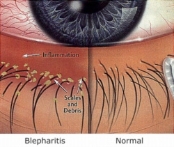Blepharitis
What is blepharitis?
What causes blepharitis?
What are the symptoms and signs of blepharitis?
How is blepharitis diagnosed?
What are complications of blepharitis?
What is the treatment for blepharitis?
What is the prognosis for blepharitis?
What is blepharitis?
Blepharitis is an inflammation of the eyelids, causing red, irritated, itchy eyelids, and the formation of dandruff-like scales on the eyelashes. It is a very common eye disorder with a wide variety of causes. It affects people of all ages. Although it may be uncomfortable, annoying, or unattractive, blepharitis is not contagious and generally does not cause any permanent damage to eyesight. The condition can be difficult to manage because it tends to recur.
What causes blepharitis?
Blepharitis involves the eyelid margins, where the eyelashes grow and the openings of the tiny oil glands near the base of the lashes are located. There may be involvement of the outer edges of the eyelid margins adjacent to the skin and/ or the inner edge of the eyelid that comes into contact with the eyeball. Changes in the skin of the eyelids or the surface of the eye itself are usually secondary to the underlying disorder of the lid margins.
The cause of most cases of blepharitis is a malfunction of the oil glands of the lids. There are about 40 of these glands in each of the upper and lower lids. When these oil glands produce too much, too little, or the wrong types of oils, the eyelid margins can become inflamed, irritated, and itchy. Acne rosacea, a generalized illness of oil glands, is sometimes the underlying cause of this process.
There are some types of blepharitis that are due to disorders of the lid margin around the lashes. These include seborrheic blepharitis, which is similar to dandruff of the scalp, and infection of the lash base by Staphylococcal bacteria.
What are the symptoms and signs of blepharitis?
Signs and symptoms of blepharitis usually are present in both eyes, affecting the upper and lower lids. They can appear at any age.
Symptoms of blepharitis include;
- itchy eyelids,
- abnormal or decreased oil secretions can result in mild tearing of the eyes,
- abnormal or decreased oil secretions can result in a feeling of dryness of the eyes,
- burning sensation in the eyes,
- gritty sensation in the eyes,
- sandy sensation in the eyes,
- foreign-body sensation
- crusting of the eyelids,
- irritation,
- decreased comfort while wearing contact lenses, and
- sensitivity to light.
Signs of blepharitis include;
- red eye lid margins,
- swollen eyelids,
- increased shedding of skin cells near your eyelids, causing flaking of the skin around the eyes,
- matting of the lashes or eyes "glued together" in the morning,
- eyelids that appear greasy and crusted with scales that cling to the lashes,
- crusted eyelashes upon awakening,
- tears that are frothy or bubbly in nature,
- eyelashes that grow abnormally,
- loss of eyelashes,
- mild scarring of the eyelid margins,
- mild ulceration of the lid margins,
- dry and flaky patches of skin on the lid, and
- dandruff of the lashes and eyebrows.
The symptoms and signs of blepharitis are often erroneously ascribed by the patient as being due to "recurrent conjunctivitis." They are also often mistakenly attributed to "dry eye" by patients due to the gritty sensation that may occur. Lubricating drops, however, do little to improve the condition.
How is blepharitis diagnosed?
Blepharitis can be usually diagnosed by a physician based on the history as given by the patient and physical examination.
The history should include a discussion of symptoms that the patient is experiencing and the presence of any general health problems that may be contributing to the eye problem.
The physical examination should place special emphasis on evaluation of the eyelids, lid margins, base of the lashes, oil gland openings, tear quantity and quality, and front surface of the eyeball using a slit lamp, which allows a magnified view with sufficient illumination.
A differentiation among the various types of blepharitis can often be made based on this examination, and appropriate treatment can be suggested.
What are complications of blepharitis?
It is unusual for blepharitis to cause serious problems. However, blepharitis can lead to a number of other conditions.
Stye: A stye or hordeolum is a bacterial infection in one of the oil glands whose opening is clogged. The result is a painful lump on the edge or inside of your eyelid.
Chalazion: A chalazion occurs when a blockage in one of the oil glands causes that gland to become enlarged and scarred.
Ulceration of the cornea: Constant irritation from inflamed eyelids or misdirected eyelashes may cause a sore (ulcer) to develop on your cornea.
Blepharitis does not affect vision generally, although a poor tear film may intermittently blur vision, causing varying amounts of fluctuating vision during the day.
What is the treatment for blepharitis?
In many cases, good eyelid hygiene and a regular cleaning routine can control blepharitis. This includes frequent scalp and face washing, using warm compresses to soak the eyelids, and doing eyelid scrubs.
The single most important treatment principle is a daily routine of lid margin hygiene. The following is a typical lid margin hygiene routine:
Soften lid margin debris and oils: Apply a warm wet compress to the lids -- such as a washcloth with hot water -- for five to 10 minutes two times a day, depending on the degree of symptoms. If you want to keep the compresses warm for a longer period of time, you may want to place a small hot water bottle over the compress. Using a clean washcloth for each cleansing is important.
Mechanically remove lid margin debris: After using the compresses, cleanse the eyelids with a cotton applicator stick soaked in a 4 to 1 mixture of water and baby shampoo or an over-the-counter lid-cleansing product such as LidCare. Gently and repeatedly rub along the lid margins while the eyes are closed. Be careful to avoid rubbing or scratching your eyes.
Limiting or stopping the use of eye makeup when treating blepharitis is often recommended, as its use will make lid hygiene more difficult.
If you wear contact lenses, you may have to temporarily discontinue wearing them during treatment.
Other treatment depends on the specific type of blepharitis. The key to treating most types of blepharitis is keeping the lids clean and free of crusts. In cases where a bacterial infection is the cause, various antibiotic drops or ointment and other medications may be prescribed along with eyelid hygiene. Depending on the degree of inflammation of the lid margin, a combination of topical antibiotic and steroid drops or ointments can be prescribed by your physician.
If the blepharitis is thought to be secondary to acne rosacea, treatment with oral doxycycline might be prescribed together with the above lid-margin hygiene routine.
Recently, there has been some evidence that oral omega-3 fatty acids may be helpful in the treatment of blepharitis.
What is the prognosis for blepharitis?
Good hygiene (regular cleaning of the area) can control signs and symptoms of blepharitis and prevent complications. Good eyelid care is usually sufficient for treatment. Such a routine needs to be convenient enough to be continued lifelong to avoid relapses, as blepharitis is often a chronic condition. One episode, however, does not signify that you have a lifelong condition.
If your blepharitis is linked to an underlying cause such as dandruff or rosacea, treating those conditions may alleviate the blepharitis.
In patients who have multiple episodes of blepharitis, the condition rarely disappears completely. Even with successful treatment, relapses are common. Taking the time to devote extra attention to good hygiene at those times may help to control the condition.


